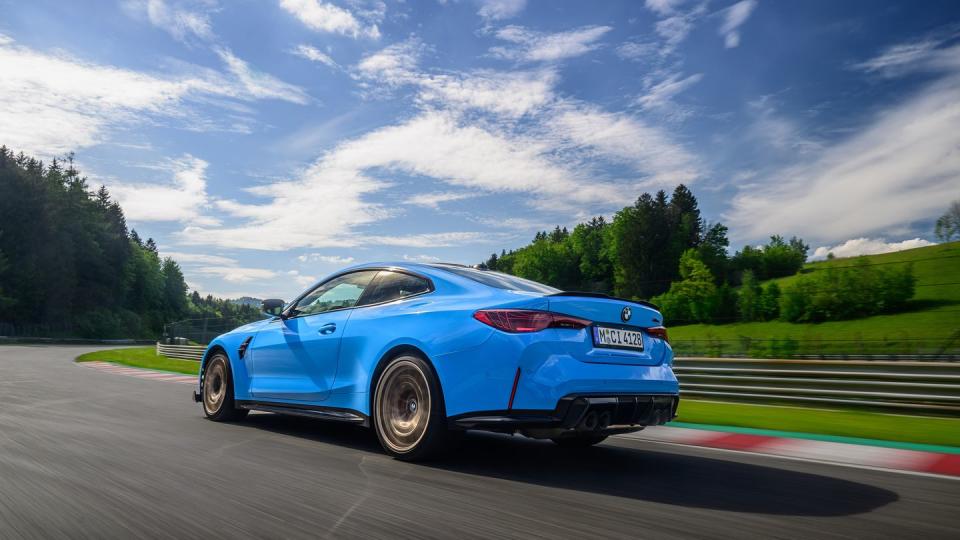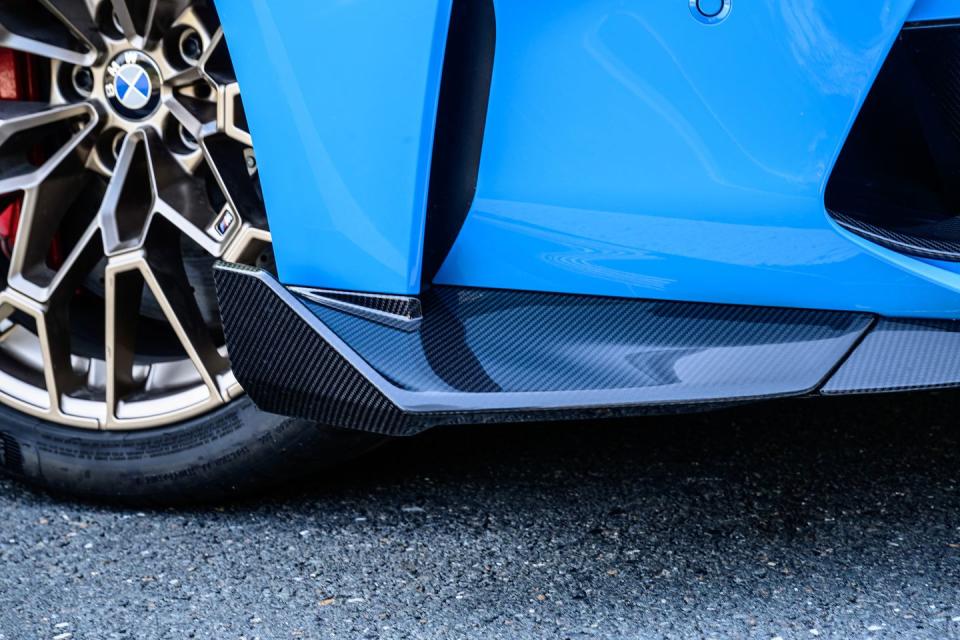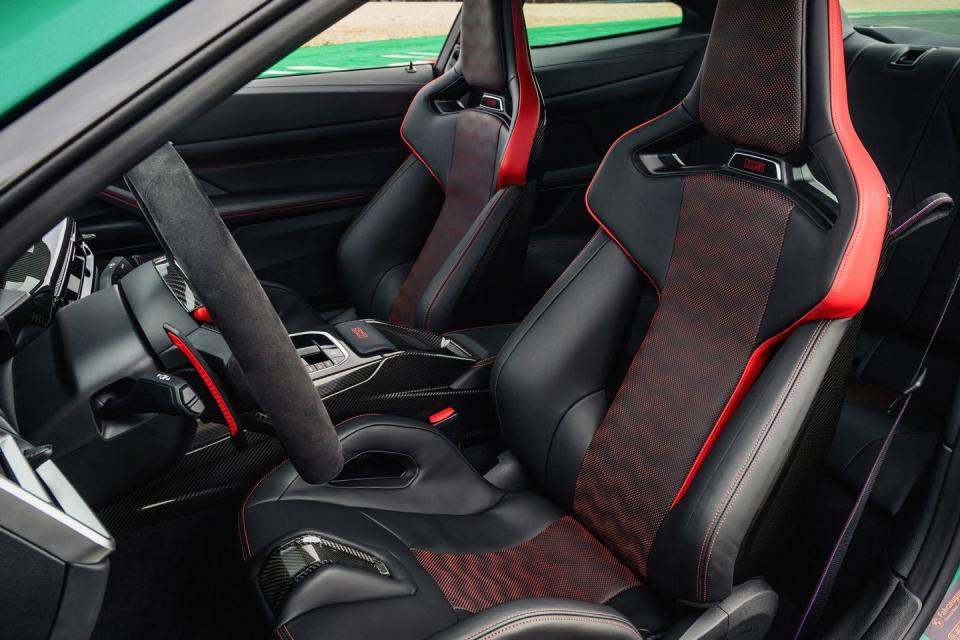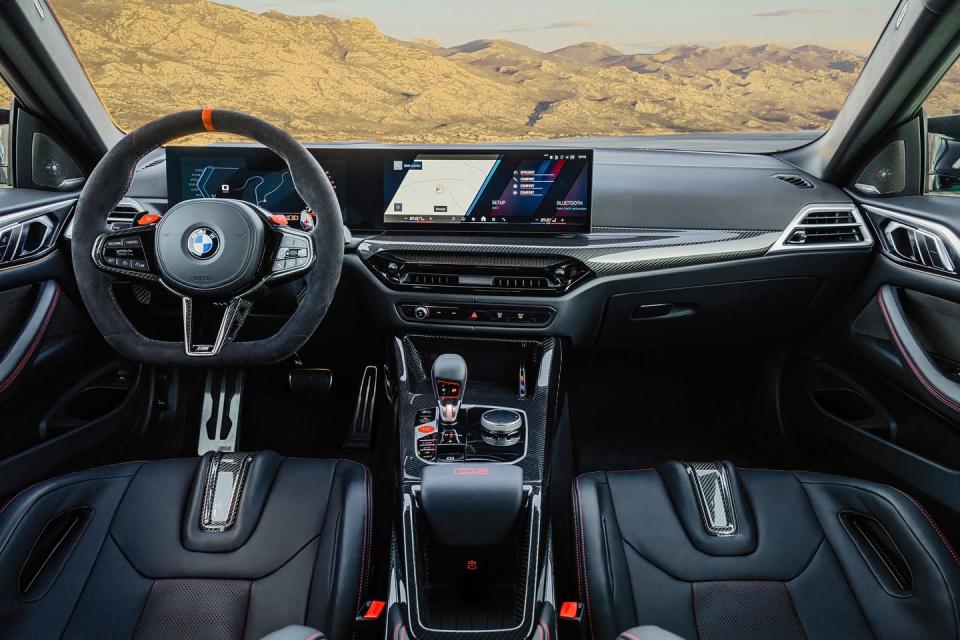2025 BMW M4 CS: Progress Is a Fickle Thing

Although it cost a whopping $140,895 and was too hardcore overall to qualify as a daily driver, the dramatically dynamic, ultra-sharp-handling, and wildly dressed-up BMW M4 CSL (limited to 1000 units) sold out instantly after its 2022 reveal. Almost exactly two years later, BMW just launched the equally eye-catching M4 CS, priced at $124,675. Despite the even more extensive carbon-fiber treatment, trademark quad headlights with yellow lenses, a choice of drop-dead gorgeous satin black or golden mag wheels, and acres of contrasting black go-faster accents, the CS is actually not nearly as extreme in character and execution as its forerunner. After all, it features four proper seats instead of two solitary racing buckets; a commendably compliant chassis setup instead of a lowered, ultra-firm, track-focused suspension; and all the expected luxury equipment instead of a no-frills full-noise cabin.
Both models share the brand's iconic top-of-the-line twin-turbo 3.0-liter straight-six rated at an identical 543 horsepower and 479 pound-feet of torque. But thanks to its standard all-wheel drive, the M4 CS beats the no-longer-available rear-wheel-drive M4 CSL to 60 mph; BMW quotes a 3.2-second time versus 3.6 for the CSL, but considering the mechanically similar M3 CS sedan did the deed in 2.7 seconds, we reckon BMW's estimates are rather conservative. To carve out the CS's extra performance, the M power brokers dialed up the maximum boost pressure to 30.5 psi, which duly increased output by 20 horsepower. In a parallel move, the engineers took out more than 70 pounds of weight. Means to this end include a lighter exhaust with a titanium silencer, redesigned low-carb wheels, a carbon-fiber hood, various slimline splitters and spoilers, four yawning grille-less nasal air intakes, and a decontented center console.

We drove the M4 CS on the Salzburgring circuit in Austria, a two-hour drive from Munich. Mixed weather ruled out the Michelin Pilot Cup 2 R track-oriented tires, which are a factory option. Instead, our Riviera Blue companion for the day was shod with Pilot Sport 4S summer rubber, size 275/35ZR-19 up front and 285/30ZR-20 in the back. A little over 2.6 miles long, the Salzburgring is essentially a pair of fast straights capped by a set of slower curves on the approach to the start-finish line and the tricky high-speed 90-degree Nockstein Corner at the western perimeter. Constantly changing radii and several elevation changes make this 'Ring more challenging than the straightforward layout suggests. Sven Esch, driver of our pace car and senior vehicle dynamics engineer of the M4 CS, knows this natural proving ground inside out. He calls out his instructions: "No 2WD, please. Feel free to dial in Track mode and MDM, but do not switch off DSC." Aye, aye, sir!
The M4 CS is fitted with thinly padded one-size-fits-some bucket seats as standard equipment. Their cushioning effect is negligible, but together with the three-point seatbelts they keep even extra-large frames firmly in place during hard braking or ten-tenths turn-in maneuvers. The steering wheel, unnecessarily squared off at the bottom, boasts a red straight-ahead marker but is almost too thickly rimmed for standard-size paws. The eight-speed transmission knows three operating modes: Auto, Sport, and Manual. We opt for the latter and select the fastest of three shift velocities, which is rapid and punchy but not nearly as wham-bang brutal as the flat-out second-to-third Sport+ whiplash in a 911 GT3. Which is exactly the point: The M4 CS will never scare you like the CSL, which loved to live its life on a razor's edge in the wet and could still be snappy and short-tempered in the dry.

Even the long back straight is not long enough to reach the claimed 188-mph top speed. We saw an indicated 144 mph before dropping the (extra-cost) carbon-ceramic anchors, which start making a difference after the second or third stint with the crowd on the pit wall still cheering. The brakes, the springs, the dampers, and the anti-roll bars all were tuned specifically for the CS. Track mode further speeds up the throttle response, sends an extra smidgen of torque to the rear wheels, delays stability control interference by a fraction of a second, and flexes the chassis muscles at the limit more energetically.
One's favorite dynamic profiles can be stored and summoned via two fire-red steering-wheel buttons labeled M1 and M2. M1 could, for instance, lock all systems in Sport or Sport+ with DSC off, while M2 may serve as a low-grip default setting with the full safety net in place at all times. Unlike Porsche, BMW M even lets the driver tweak the key dynamic man-machine interfaces, namely steering response and brake action. Although the difference between Comfort or Sport is relatively subtle, we would prefer a stable feedback under all driving conditions. It is in this context worth mentioning that BMW steering has over time gradually lost some of that deeply reassuring connectivity and total haptic immersion that peaked in the legendary E46 M3. Even in a sharp-handling and commendably involving sports coupe like the M4 CS, electric actuation and electronic control has to an extent traded crispness and sparkle for reduced effort and enhanced safety.

Having said that, the M division's latest effort still is a highly emotional piece. Hit the red starter button, watch the digital displays pop into life one after the other, listen to the exhaust at idle, then blip the throttle and compare the sound to the selected drive mode. Too subtle? Hit the exhaust button, dial in Sport+, then check again. That's better. Now, pull the gear-lever into Drive and take off. What's next, Herr Esch—another qualification lap or a long run? Although the vocal inline-six redlines at 7200 rpm, the torque curve plateaus from 2750 to 5950 rpm, warranting plenty of midrange grunt. The shift lights on top of the speedometer and the tach instantly reflect every change of rhythm, but unfortunately the instruments retain silly square bracket graphics rather than more readable old-fashioned round dials. Although BMW removed the center armrest without asking for permission, at least the iDrive controller survived as a comforting fixture for touchscreen haters.
Two five-lap runs and some bonus track time doesn't sound like nearly enough to evaluate a new car, but then the M4 CS is in essence a familiar quantity spruced up with a few fresh talents. Although it looks like a facelifted CSL, its road manners, ride comfort, performance, and equipment are more like an M4 Competition xDrive's with a twist. Trouble is, that twist will cost you an extra $35,200, which is a lot of bread even if the production run will end, as rumored, after only one year and 2000 units, thereby likely bolstering the resale value. But right here and now, a base model M4 with standard seats and a wider choice of options seems like the more compelling bet. Feel free to save even more by opting for the 503-hp $84,375 rear-wheel-drive version, or secure a future classic in the shape of the 473-hp M4 manual priced at $80,275. Although the CS is the perfect 10 that beats the rest of the range on merit and appeal, that wafer-thin dynamic advantage comes at an uncool premium.

You Might Also Like

 Yahoo Autos
Yahoo Autos 